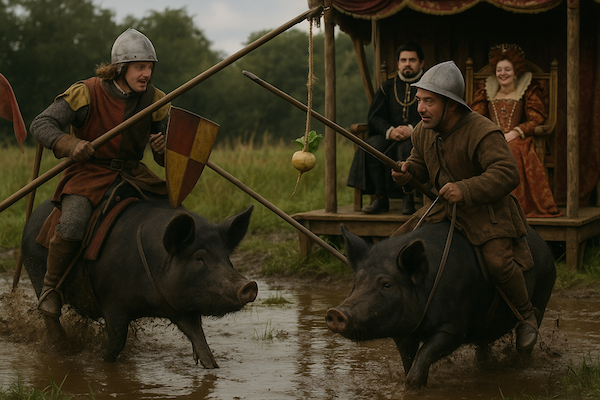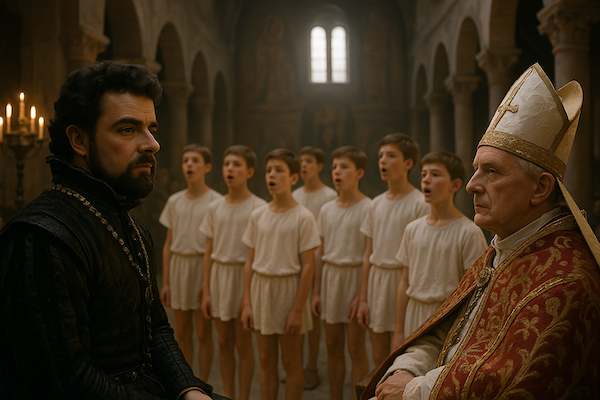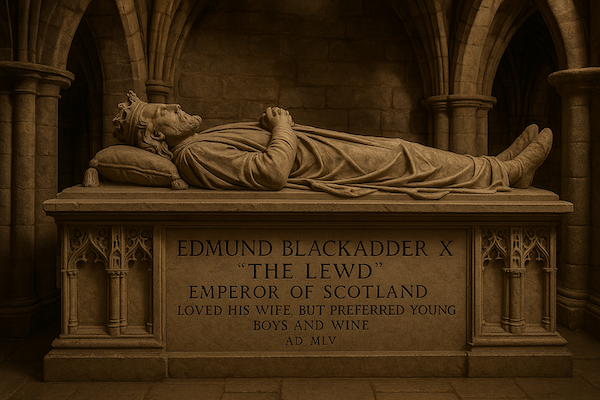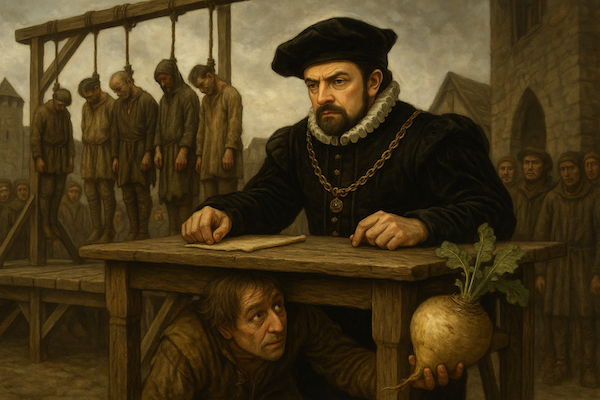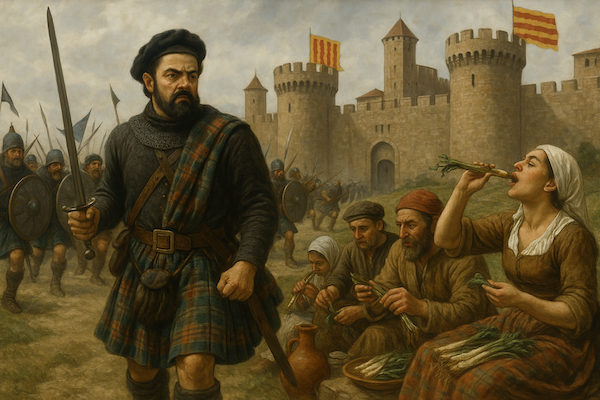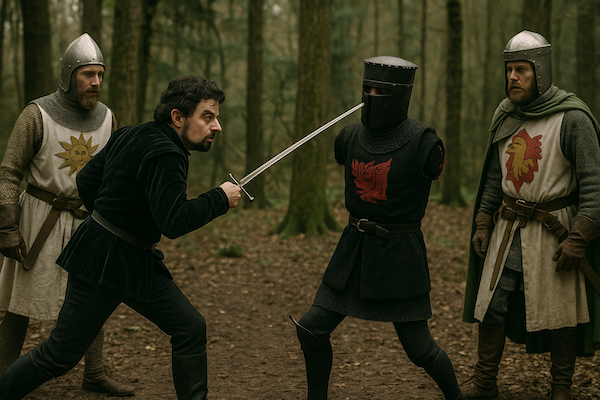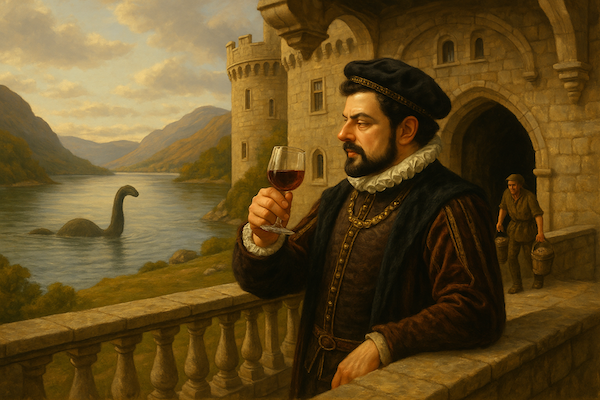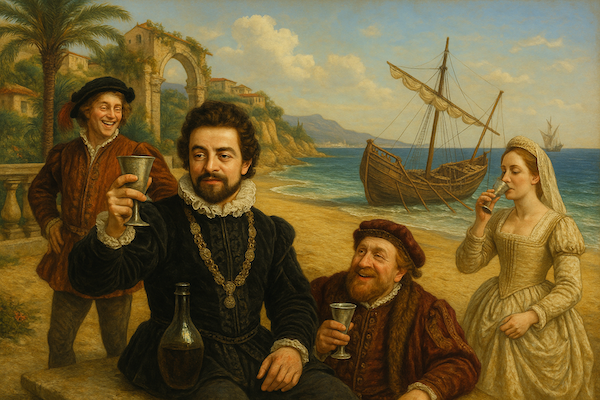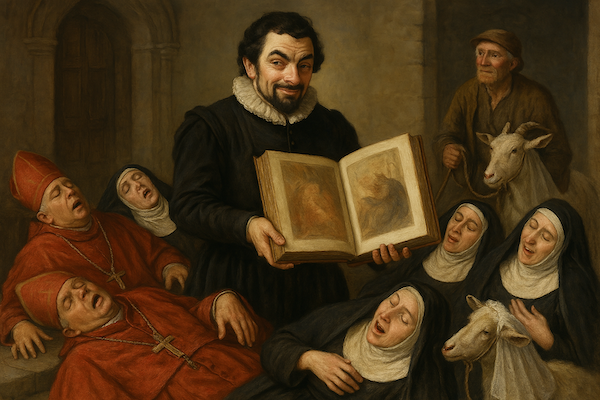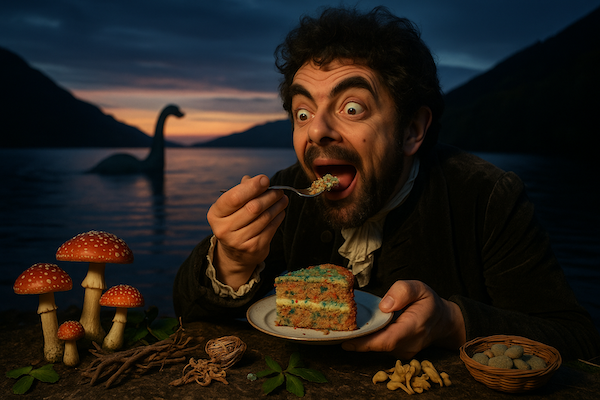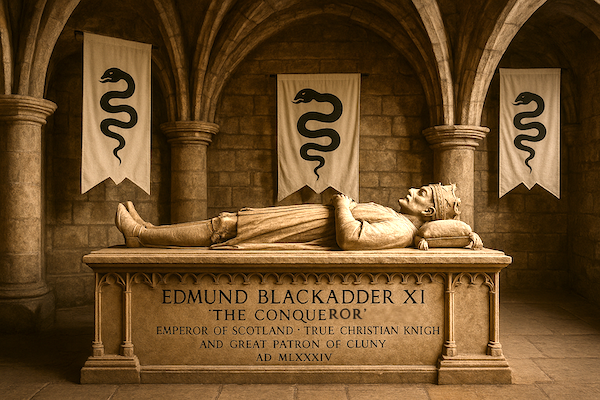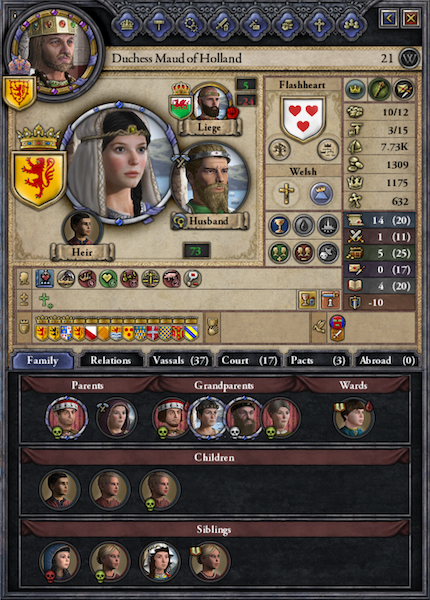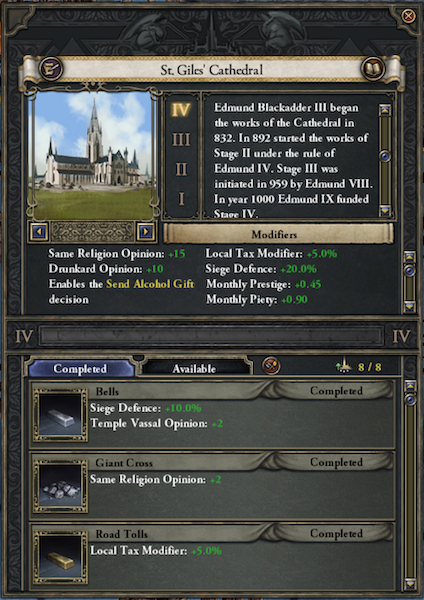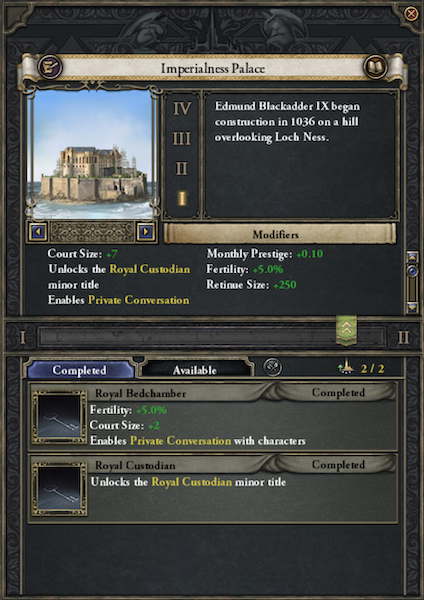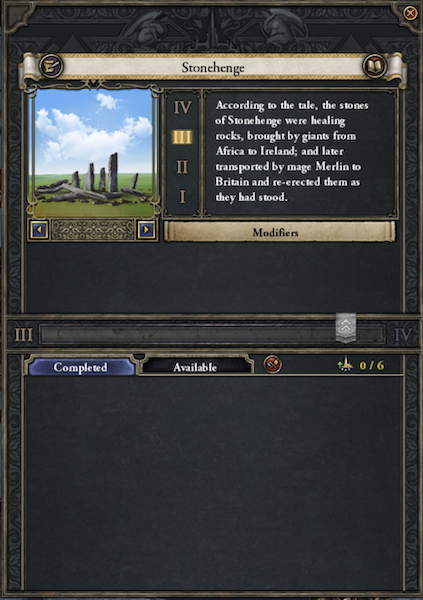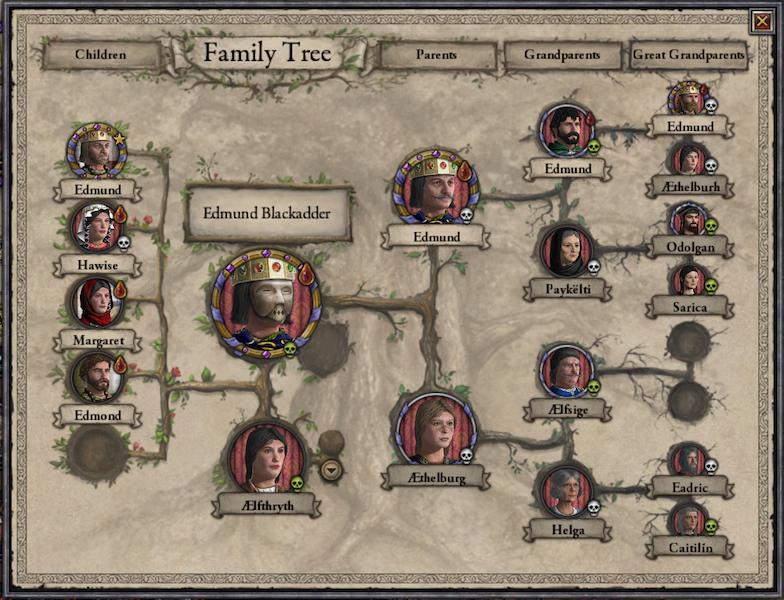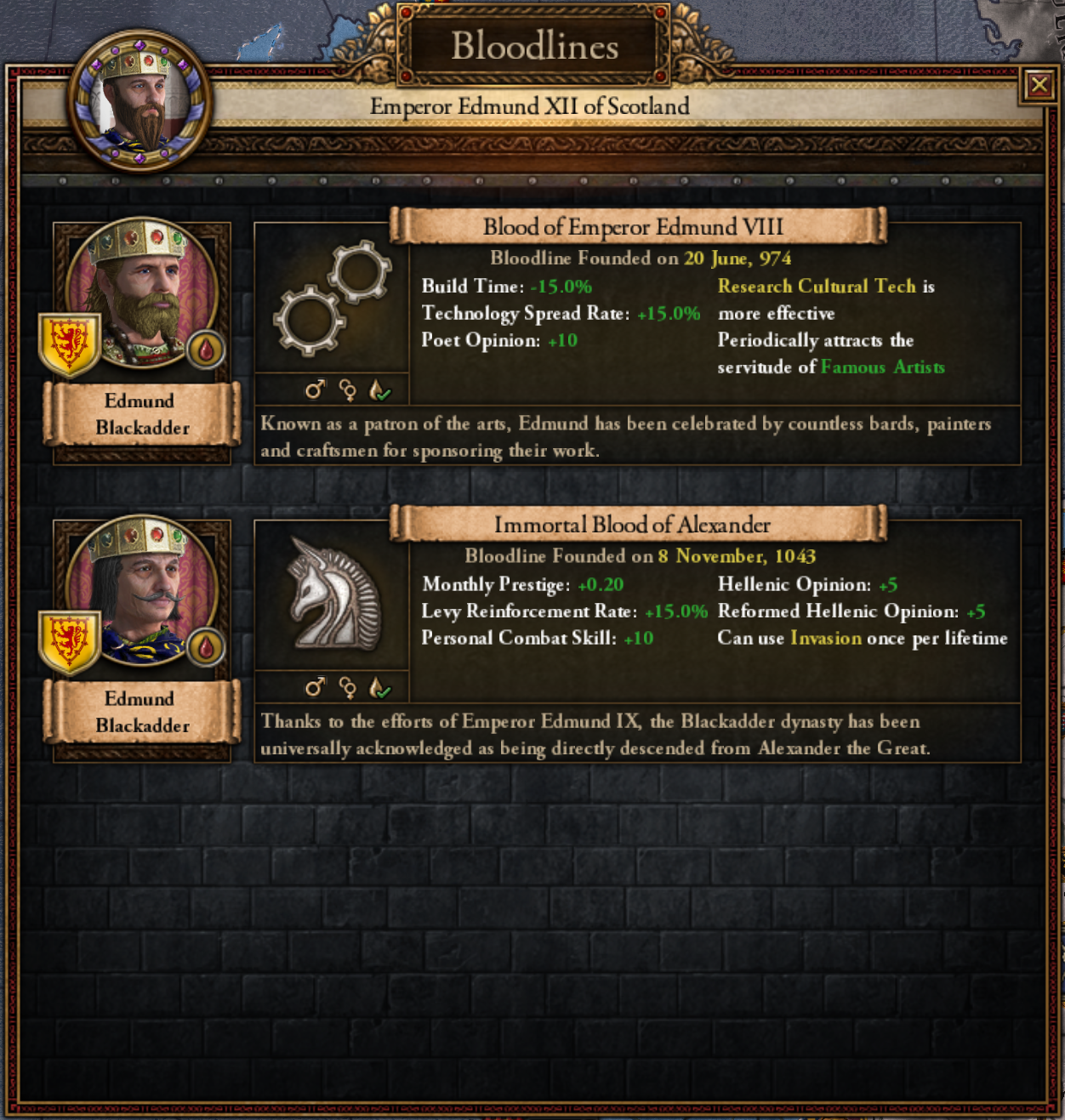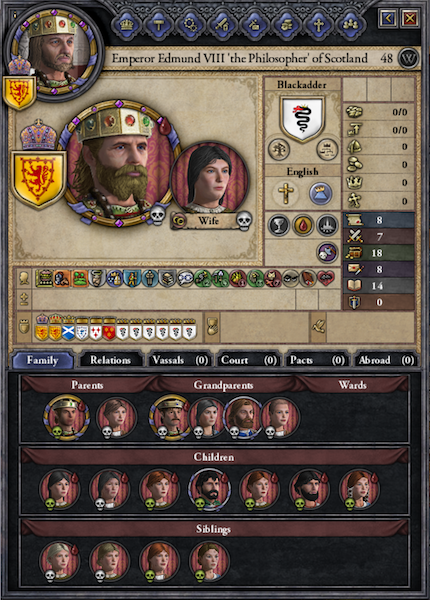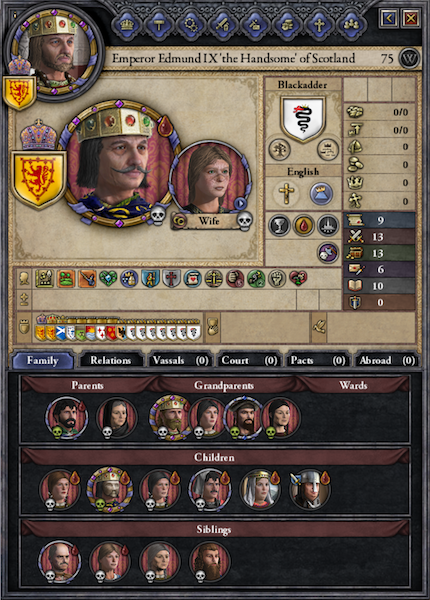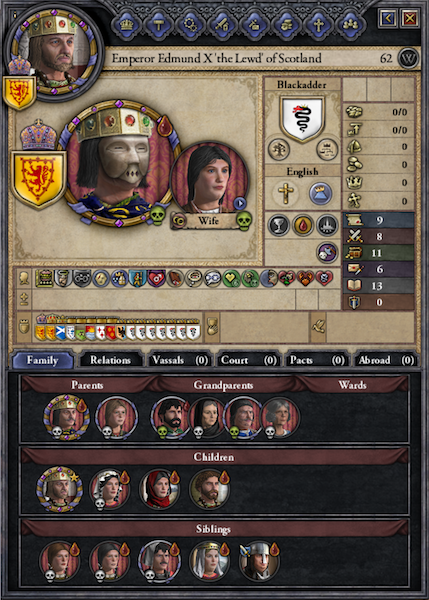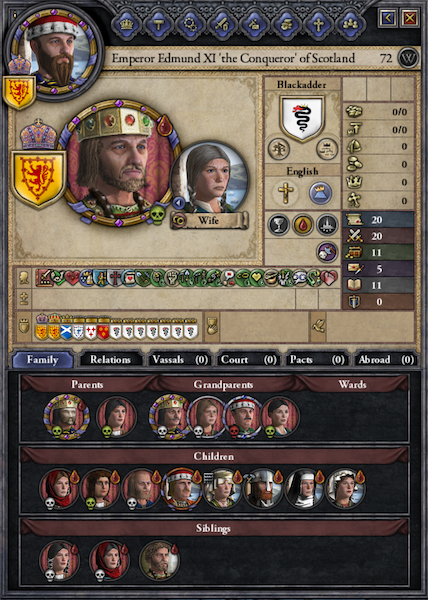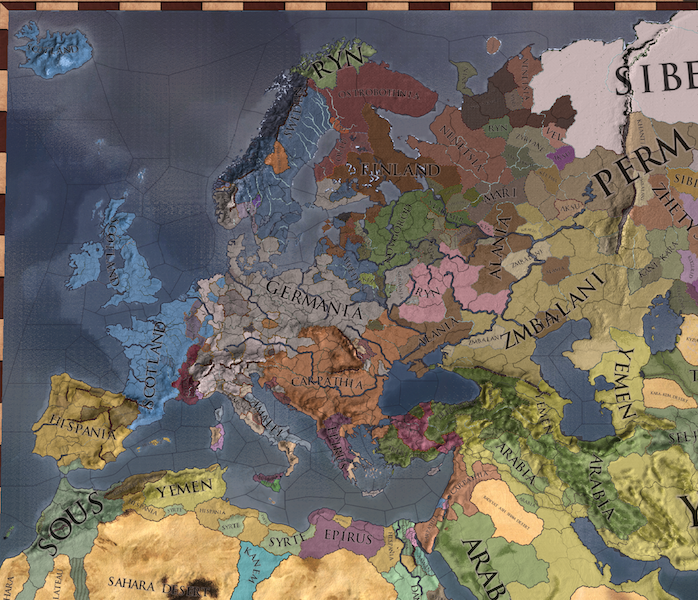ADDENDUM C - 300 years of Blackadder cunning rulership (769-1069)
In the Year of Our Lord 1069, Scotland reluctantly raised a goblet (and kept the other hand on its sword) to mark three full centuries since the first Blackadder slouched onto the throne of Edinburgh, a moment historians not yet agree was either the birth of a nation or the start of a very disgraceful joke.
Three hundred years of scheming sovereigns, suspiciously-timed coronations, and a foreign policy best described as hope for the best, bribe the rest. Monarchs came and went (usually with no purpose), alliances shifted like the Scottish weather, and taxes remained the one true constant, levied on livestock, land, rain, and, during the Black Death, funerals.
The Blackadder line, through some mix of luck, lies, and occasional literacy, endured not only their enemies but also their own cousins, councils, and culinary choices. They built castles, fought crusades, created monsters, and most importantly, managed to cope with Baldrick cunning plans most of the time.
Let us now turn a shrewd and slightly suspicious gaze upon the third century of the Blackadder era: a time of political pageantry, feudal feuds, and an alarming number of statues with noses mysteriously missing. We shall explore the pomp, the pitfalls, and the peculiar genius that kept the Blackadder name firmly, and sometimes literally, carved into the stonework of Scottish history.
THE NOBLE HOUSES
House Blackadder : Scotland's inexplicably enduring royal family since 769, founded by the ever-opportunistic Edmund Blackadder I, a man best described as ambitious and worst described in most taverns. For 300 years, the Blackadders have gripped power like a toddler clutching a stolen sword: recklessly, loudly, and with several lawsuits pending. Their strategy meetings usually end with the wrong map, the wrong army, and the worst wine. Senior appointments have gone to drunk uncles, confused monks, and, in one memorable case, a horse with a shining armor. Of the 338 Blackadders recorded in official chronicles, 90 are still alive as of 1069, mostly because the assassins gave up or joined the family payroll.
House Baldrick : Faithful retainers, occasional liabilities, and full-time catastrophes, House Baldrick was inexplicably granted the Duchy of Albany in 849; either as a reward for loyalty or a punishment for proximity. Since then, their energies have been divided equally between turnip cultivation and accidentally setting things on fire, and sometimes both at once. Their role in Scottish politics has been largely unintentional, often involving misread scrolls, misplaced votes, and speeches delivered to the wrong audience. Their most enduring legacy is a 200-page treatise on agricultural reform, which turned out to be a shopping list with ambitious handwriting. Though feared in council chambers, mostly for their hygiene, the Baldricks have somehow endured. As of 1069, a total of 161 have been recorded, with 31 still alive, or at least unburied; which, by family standards, is practically thriving.
House Darling : After three centuries of service to the crown, and even longer avoiding any actual responsibility, House Darling remains a shining example of what happens when nobody notices you’re in charge. Granted control of Galloway in 842, mostly because the Blackadders refused to go that far west without bathhouses, the Darlings have governed with all the decisiveness of a lukewarm pudding. Their greatest accomplishments include not starting any wars, not ending any either, and once inventing a new form of paperwork by accident. To date, 247 Darlings have graced the records, with 49 still alive in 1069, most of whom are believed to be waiting for instructions that were never given. And yet, in the grand chaos of Scottish politics, perhaps doing nothing is the most cunning move of all.
House Flashheart : Renowned for their dazzling bravery and catastrophic judgment, the Flashhearts have been safely -
ahem, strategically - stationed on the Isle of Man since 842, mostly to keep their heroic misfires a safe boat ride from Edinburgh. The official line is that it was a noble posting; unofficially, it's the only place big enough for their egos and small enough to limit collateral damage. Despite being given an island and strict orders not to leave it, the Flashhearts somehow conquered parts of Holland, Flanders, and Picardie, purely by yelling loudly, charging in the wrong direction, and accidentally defeating several confused enemies along the way. Of the 170 Flashhearts proudly named in the chronicles, 30 were still alive in 1069; though with this family, alive includes anyone still shouting, bleeding flamboyantly, or attempting to seduce passing horses. Their motto remains: Glory or Burst!
House Percy : Despite possessing neither intelligence nor courage in dangerous quantities, the Percys somehow blundered their way into ruling the Duchy of Moray in 888, a gift from Edmund Blackadder IV ‘One-Hand’, who historians suspect may have been concussed, drunk, or both at the time. Now headquartered in Aberdeen, with occasional seasonal migrations to Inverness, the Percys move much like confused livestock: slowly, loudly, and usually in the wrong direction. Their approach to governance consists mostly of guesswork, shouting, and hoping someone else writes it down. So far, 261 Percys have stumbled through the pages of Scottish history, with 31 still lingering in 1069, either lost, locked in cellars, or enthusiastically misunderstanding their titles.
House Melchett : Appointed Dukes of the Isles in 889, presumably because no one else wanted the job, the Melchetts have ruled the Hebrides with a proud tradition of blustery speeches, poor decisions, and accidental fires. Their reign has ranged from mildly inconvenient to national apology. By some divine mix-up or paperwork error, a cadet branch accidentally became royalty in France, catapulting the family into European relevance by 969, much to the horror of France, Scotland, and the Melchetts themselves. Thank God, the throne lasted them less than a piece of candy at a school party, and France breathed a sigh of relief. Back home, the original line remains heroically entrenched on the wind-scoured rocks of the Hebrides, locked in an eternal struggle against bad weather, worse judgement, and the occasional airborne livestock. To date, 158 Melchetts have graced the records, with 50 still living; a fact that continues to confuse medical science and possibly God Himself.
House MacOrkney : Originally a Pictish clan strong-armed into service by the Blackadders to manage the northern isles, mostly because no one south of Inverness fancied arguing with people who painted themselves blue and threw rocks for sport. Their first noble, Lord Paul MacOrkney, was granted the title of Duke, despite showing more interest in sea shanties than statecraft. While his political legacy is fuzzy at best, his musical instincts were unmatched, and to this day, his ability to lay down a solid beat during council meetings is the stuff of bardic legend. Diplomacy may have escaped him, but rhythm never did. Though their policies were often improvised and occasionally in 6/8 time, the MacOrkneys have endured. History notes 86 family members, with 30 still alive in 1069, many of them still tapping their toes, tuning their harps, or simply rocking back and forth in highland chairs muttering about the good old gigs.
House Threepwood : Living proof that sometimes sheer luck, poor navigation, and wildly misplaced confidence are all you need to found a noble house. Lord Guybrush Threepwood, once a young sailor with dreams of adventure, tropical islands, and an unhealthy number of monkeys, somehow ended up in the freezing north. After accidentally impressing Edmund VI ‘the Cruel’ during the Icelandic campaign of 923 by not dying immediately, Guybrush was rewarded with rule over Reykjavik, a decision many chalk up to frostbite-induced delirium. Though no monkeys have ever been spotted, the Threepwoods have embraced Icelandic rule with their trademark blend of naïve enthusiasm, overly confident speeches, and a deeply flawed understanding of diplomacy. With 86 family members recorded so far, and 42 already spirited off by LeChuck or similar career hazards, the house remains small but confusingly optimistic.
House Bufton-Tufton : Often overlooked by the Blackadders, mostly because they were usually lost, the Bufton-Tuftons managed to stay blissfully unimportant in Scottish affairs until 950, when the Blackadders decided to expand into Ireland and thought, Why not send the Bufton-Tuftons? What’s the worst that could happen? Miraculously, they were granted the Duchy of Munster, likely because they were the only ones who showed up on time. Since then, their claim to fame has been a baffling mix of accidental victories, and endless confusion over which side they’re supposed to be on. To date, 109 Bufton-Tuftons have graced the family tree, with 26 stubbornly refusing to kick the bucket, mostly because no one can quite find the instructions on how to do it properly.
THE KINGDOM
A short review of the last century in Scotland, chronologically ordered, and started with Lord Edmund Blackadder VIII (see Addendums A and B for previous rulers).
Lord Edmund Blackadder VIII ruled as 'the Young' for a solid 14 years before earning the far more fitting title of 'the Philosopher' mostly to his bizarre experiments, endless unsolicited advice, and occasional flashes of accidental wisdom. While his commanders were busy annexing Ireland, Wales, and Brittany, Edmund VIII was preoccupied with his greatest project yet: cross-species breeding experiments at Loch Ness. He also holds the dubious distinction of being the only Blackadder to ever move the royal court out of Scotland. During the Black Death, he either cunningly or cowardly relocated the entire operation to Iceland, proving once and for all that a good strategist knows when to run for colder pastures. Before his demise, Edmund crowned himself Emperor of Cunning, a title that was enthusiastically ignored by every pope, cardinal, and sane person ever.
Lord Edmund Blackadder IX, also known as 'the Handsome' (a title he insisted on repeating constantly), was raised in Jaffa, near Jerusalem; because nothing says future Emperor of Scotland like growing up in a sun-drenched Crusader outpost. Thanks to the untimely deaths of both his father and grandfather, Edmund ascended the throne at the tender age of 11. The Pope graciously agreed to uphold the Imperial dignity, though he firmly rejected Edmund’s request to be called Emperor of Cunning, likely due to an incident involving forged relics and an exploding cassock. During his reign, Stage III of St. Giles’ Cathedral was completed, including its now-famous attached brewery, and Edmund immediately began plans for Stage IV, which included indoor plumbing, a falconry disco, and at least three fountains shaped like himself. By sheer luck, dumb bravery, and a few well-timed poisonings, Edmund also managed to unite France, Holland, and bits of England under the Scottish Empire, which, according to his official biography, was cunningly planned. His final project was the Imperial Palace at Loch Ness, a glittering monstrosity that greatly offended local fishermen, still bitter over his predecessor’s attempts at romantic interspecies diplomacy.
Lord Edmund Blackadder X 'the Lewd' ruled the empire for roughly ten years, a decade blissfully devoid of major events, accomplishments, or anything remotely resembling effort. His reign is best known for his legendary nightly festivities, which featured copious amounts of wine, an unsettling number of young male servants, and his wife’s studied, silent ignorance; a marital strategy historians now refer to as Selective Blindness with Royal Benefits. Oddly enough, despite his complete disinterest in governance, Edmund X is remembered as one of the most beloved rulers in Scottish history; mostly because he didn't raise taxes, declare wars, or accidentally set fire to any cathedrals. The people enjoyed a rare era of peace, prosperity, and the thrilling national pastime of not being bothered by their monarch. In short: he did nothing, and the nation cheered.
Lord Edmund Blackadder XI 'the Conqueror' enthusiastically continued his predecessors' clever strategy of dividing France into bite-sized duchies, encouraging them to squabble endlessly over land, power, and the last decent croissant. With no real internal threats, aside from the occasional tax rebellion or drunken duke misplacing a province, Edmund XI turned his gaze southward. He annexed Barcelona, mostly for the weather, and subjugated England before the Knights of the Round Table could figure out where Assyria was or why they should care. Though the Imperial Court remained in Edinburgh, Edmund XI spent his summers at Loch Ness, enjoying the view from his lavish new palace, paid for with English gold and French complaints. The local fishermen still refused to speak to him after the Nessie Incident, but Edmund XI considered that a bonus. He survived the year 1069, which was more than could be said for several of his mistresses, and the second half of his reign will be covered in Addendum D, assuming time behaves itself.
THE WONDERS
The legacy of the Blackadders will outlast kingdoms, reason, and most likely the human species; forged in stone, funded by peasants who received nothing in return, and upheld by a centuries-long tradition of sarcastic decrees and creative tax policies.
St. Giles’ Cathedral still stands tall in Edinburgh, guiding Scottish souls to Heaven (or at least the general direction) while conveniently diverting clergy tithes straight into the Blackadder coffers. It remains a holy place of worship, spiritual reflection, and aggressive accounting.
The Imperialness Palace, originally built as a symbol of imperial grandeur, quickly became the Emperor's summer resort, with a floor plan clearly designed by someone who hated everyone but the monarch: only the Emperor’s bedchamber has a window facing the lake, and the rest face walls, sheep, or other disappointed nobles. Its underground tunnels are rumored to house strange creatures, ancient secrets, and Baldrick, who's been lost down there since 1042 and may now be part mole.
As for Stonehenge, the mighty circle of mysterious rocks, it was acquired along with the Crown of England, mostly because no one was guarding it and the Blackadders thought it would look good as a giant sundial or possibly a barbecue pit. To this day, no one knows what it does, but it definitely belongs to Scotland now… because it can't say otherwise.
THE ROYAL PORTRAITS GALLERY
Continuing the gallery from Addendum B, here below you can find the Blackadder family tree, starting with Edmund VIII 'the Philosopher'.
Both Edmund VIII and Edmund IX left a legacy so deep, archaeologists need permits just to look at it. Their descendants still enjoy royal treatment when traveling across Europe, mostly because people assume they’re either famous nobles or eccentric performance artists. Either way, they rarely pay for drinks.
THE WORLD IN 1069
Scotland has risen as one of the great European powers under the infamous rule of House Blackadder. Its vast empire now stretches from Iceland to Barcelona, as if someone drew a slightly drunk line across Europe, conveniently passing through Greenwich. It even keeps a foothold in Jaffa, serving as a safe port for pilgrims en route to the Holy Land.
To the east, the Catholic Empire of Germania controls most of Eastern Europe, while the once-mighty Holy Roman Empire has been reduced to a narrow, nervous strip wedged in between like theological dental floss. The Kingdoms of Burgundy and Austrasia are now sandwiched awkwardly between these powers, constantly pretending not to notice.
To the north, Sweden has somehow managed to unify the heathen chiefdoms under a New Reformed Pagan religion, which mostly involves longboats, loud chanting, and suspiciously well-organized raids.
In the south, the Saracens still hold Hispania and the African coast, while the Merchant Republic of Amalfi has seized most of Italy, presumably by buying it. After the fall of Constantinople, a new Sultanate has emerged in Carpathia, while the people of Greece have rallied under the flags of Epirus and even taken control of Cyrenaica.
As for the rest of the world ... it remains, for now, too far away for the Blackadders to care about. But give it time.



